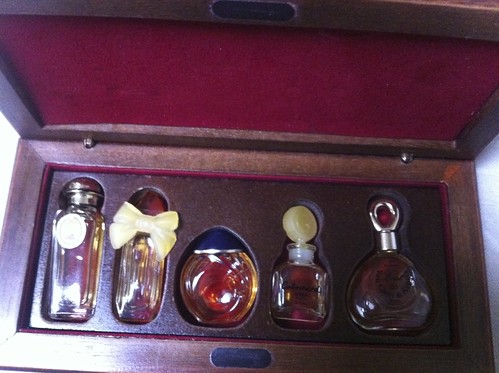Cabochard was reated in 1959 by perfumer Bernard Chant for French couturier
Germaine Émilie Krebs (publicly known as Alix Grès or Madame Grès). Cabochard in many ways preceded its time and the trend that will dominate the 1970's - green, formal florals, often soapy, and at times even icy. However, while Cabochard is definitely green, it has the joie de vivre of the genre's founder,
Vent Vert, and a warm yet playful personality which I can only guess has a lot to do with Madame Grès' vision and personality.
While most of the successful couturiers fashion houses of Paris followed their success to become more commercial, the house Grès remained purely dedicated to haute-couture. Everything was done by hand, made to measure, and with utmost attention to detail. This can usually only last as long as the founder is alive and working. And so, sadly, when Madame Grès retired in the 1980's, the business was sold, but while the couture was pretty much lost, the fragrance part remained alive and kicking, even if they don't launch a new fragrance every other day...
I came across Cabochard before, but wasn't really "grabbed" by it until a generous perfumista gave me this vintage coffret of minis of various concentrations, which is probably from as far back as the 80's. Enough time to disintegrate the rubbery lid (I had to use an actual corkscrew to pluck it out!) but it has retained its scent beautifully.
I was first intrigued by the scent; then by the story of Madame Grès - whatever of it I was able to pick from the very little information is found about her - mostly in French. She's not nearly as known as Gabrielle Chanel, and even more enigmatic. She was married to the Russian sculptor Serge Czerefkov, which I'm certain had some influence on her art:
her pieces have the a solid structure wrapping around the female form, yet draping in innovative ways, showing the fabric's flow, texture and bringing out intriguing shapes and silhouettes by the interaction between body and garment. As to her personal style - she seems to be sporting a turban at almost all the photographs of her, which makes me wonder if she had hair at all, or was just obsessed with the Orient.
Cabochard means stubborn or hard-ass in French, and the personality of this fragrance makes me think that there is something to it. I was, however, surprised to find out via
Fragrantica (and upon further investigation in Michael Edward's Perfume Legends), that her fascination with India is what inspired both Cabochard and another twin fragrance called Chouda, supposedly a floral, which never quite came to be. The latter was designed by Guy Robert, and was an ethereal floral, to resemble a flower she encountered in India, possibly water hyacinth (which I find unlikely, as it is native to the Amazon basin). By the sound of the name, I think it might have been kewda, which has hyacinth-like quality. Although this was reportedly Madame Grès' personal favourite between the two, she decided to go with the bold green chypre, which was more trendy at the time.
Despite some marketing material alluding to Cabochard being inspired by a walk on the beach of Southern India (again, rather unlikely that a tropical beach would smell that green and bitter), there is nothing quite India-related in Cabochard as far as I can smell. But it sure smells like a strong-headed gal with a great sense of humour, which is how I imagine Madame Grès to be in real life. Some further reading also revealed that
unlike Chanel, she strongly opposed the Nazi occupation of Paris, and insisted on displayed the tricolor flag on her shop (which ultimately resulted in the Nazis closing her shop). I admire her now not only for her talent, but also for her courage.
Cabochard is so many things - green, leathery, woody, floral, indolic... It begins with a definitive juicy-green character, like frsehly squeezed wheatgrass; yet there is something ashy and dry underneath. The health-concious wheatgrass juicer is also a chain smoker. The nicotine in her veins brings the best of her - creativity, energy, laughter. It's balanced again with some medicinal sage, and pretty, clean and proper neroli and enough rose to make you think of a rose garden but not smell like an English lady. Orange blossom and jasmine make advances as the perfume develops on the skin. These two bold notes, while indolic and dirty, also have a zest of life to them, a very forward personality, with the methyl anthranilate shining through beautifully and bringing some sweetness into the green. They are only ever so slightly soft-focused with powdery orris note. As for the base - it's what you've always dreamed of: oakmoss, tobacco and vetiver, with some
isobutyl quinoline for good measure.
Cabochard to me seems to have predicted the future of the 1970's - No. 19, especially, to whom it is a very close relative with the same motifs of leather, greens, juicy citrus notes, iris, leather and vetiver; interplay between green, dry and floral-powdery. As well as everything that followed, dominated by green, herbaceous and soapy notes. The leading scents in this trend were
No. 19,
Ivoire, Estée Lauder's Azurée (by perfumer Bernard Chant), Alliage and
Private Collection; Coriandre, Calandre,
Chamade,
1000, AnaisAnais, and
Aromatics Elixir (also designed by Bernard Chant), and of course Rive Gauche. I'm glad I found out who is the perfumer behind it (though I'm certain that Guy Robert's Chouda was magnificent!) and see the connections with his other creations.
Top notes: Sage, Rose, Neroli
Heart notes: Jasmine, Orange Blossom, OrrisBase notes: Vetiver, Leather, Oakmoss, Tobacco




